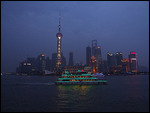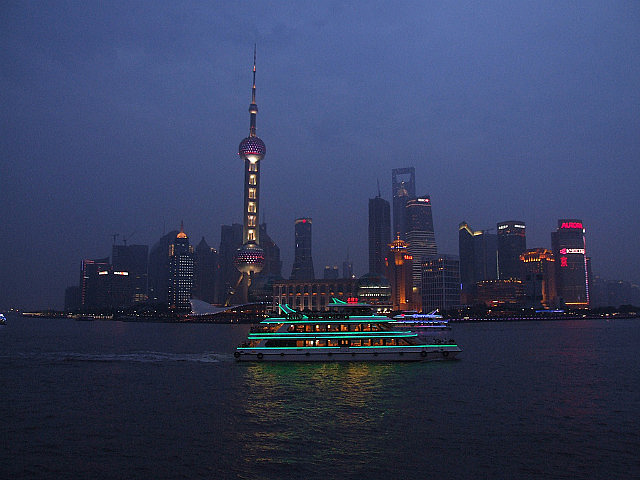Shanghai is not a very old city but it draws culture and vitality from the Yangtze Delta region, the most fertile and advanced region of China in the imperial times. As the main port of foreign trade of China before the communist revolution Shanghai developed into "Paris of the Orient", a fabulous semi-colonial city whose core neighborhoods were leased to various colonial powers. Under such massive foreign influences Shanghai became a place where a Chinese mercantile class first came into existence, and along with it the development of modern media, advertising, and film industries. Shanghai continued to produce a fifth of China's economic output after the communist revolution, despite having just one one-hundredth of China's population. However, the cutoff of foreign trade during those years saw Shanghai's economic position surpassed by Hong Kong; in fact many of Hong Kong's business moguls were exiled Shanghainese.
I have been to Shanghai many times but never spent much time sightseeing. In the past Shanghai gave me an impression of being full of overcrowded shanties, and a place without much notable history or culture (this probably has to do with me growing up in Beijing). This time is different however. Shanghai has changed. It is hosting the 2010 World Exposition, the most expensive exposition ever. It has developed East Asia's highest and most spectacular skyscrapers. It has become an international mega-city once again, where the local people's innate sophistication, style, and business acumen are put to good use.
The French Concession neighborhood was the focus of our first day in Shanghai. Away from downtown business districts and having many 1920's colonial villas, this neighborhood has become an internationally trendy neighborhood of high-end boutiques, art galleries, bars and clubs. Vestiges of French and European architecture styles can be seen but overall there is an eclectic, understated, and laid-back feel, with streets shaded by neat rows of french plane trees. The Xintiandi shopping complex was an amazing development that converted old-time brick tenement housing into chic coffee shops, restaurants, bars, and boutiques. A fascinating museum in this complex showcased how a typical middle class Shanghainese family in 1920's would have lived.
In the evening we explored the downtown shopping districts. While walking around Shanghai we could find ultra-modern shopping malls every few blocks, evidently supported by a high density of population and average incomes higher than elsewhere in China. The glitzy, pedestrianized Nanjing Road was incredibly crowded, filled with masses of domestic tourists coming to Shanghai for the World Expo. Same with the subways, which was swarming with so many people it would be totally hopeless if we had to wait in line to buy tickets (my aunt and uncle loaned us their magnetic transit cards) either at the ticket machines or the ticket booths. Within the corridors of the subway stations we needed to squeeze in-between the wall-to-wall crowds in order to get through, it was very uncomfortable. Finally, we made our way to the Bund - the waterfront promenade with views of the Huangpu River, the shipping artery of Shanghai. Across the river are the glitziest and tallest skyscrapers in all of Asia (Dubai is the only competition), bathed in a symphony of flashing neon lights. This side of the river are a long row of grand turn-of-the-century colonial high-rises formerly occupied by major international banks and corporations. Incredibly large numbers of people were camped out on the Bund, probably a hundred thousand or more, joining in the nightly spectacle of light shows.
We spent most of the next day to tour the World Exposition. We've already heard from many people about the crowds and the long lines, and saw pictures from my mom and aunt visiting the Expo. We planned to visit only the pavilions that did not have long wait lines. In fact the whole process was surprisingly smooth, beginning with a special bus from our nearby subway station that went directly to the Expo. Once past security check at the gates, we saw that the grounds are huge so the crowds were dispersed effectively. We visited 10 pavilions (Central and South America Combined Pavilion, Cuba, Tunisia, Libya, Argentina, Nigeria, Africa Combined Pavilion, Romania, Portugal, Morocco) in one day, which is much more than what most people thought possible. What impressed us most were the Romania and Morocco pavilions. We entered Romania pavilion without waiting in lines because we had lunch at their high-end restaurant. Their pavilion focused on showcasing Romania as a stylish country with high fashion, rich music, and good wine. We sat inside the theater seating area shaped like a half of an apple and enjoyed a beautiful string quartet performance. The Morocco Pavilion was impressive for its architectural grandeur: every surface was either polished stone, carved wood, mosaic tiles, or covered with hammered copper, it was the most elegant building and seemed very expensive to build. Inside it had graceful horseshoe arches, palm trees, traditional Islamic fountains, intricate carpets, and all kinds of beautiful objects showcasing Moroccan people's rich artistic traditions.
We took two ferries on the Huangpu river for sightseeing and also to get to the east end of the huge Expo grounds. Here were many of the largest pavilions, including the China Pavilion and the Saudi Arabia Pavilion, both of which were virtually impossible to get in. The huge clam-shell shaped Expo Performing Art Center, and the gigantic alphabet shaped Korea Pavilion were very impressive as well. In the midst of all this hubbub, we found a surprisingly calm oasis surrounded by handsome bamboo groves. Designed like a Suzhou garden but smartly adapted to modern architecture, this is an oasis of local traditions away from the onslaught of the cosmopolitan mega-city. In the evening the grounds of the Expo was a world of glowing neon lights, while competing for attention are many pavilions whose exterior walls feature huge TV screens (LED arrays) constantly playing videos.
Later that evening we explored the popular Yuyuan shopping district, a place like Nanjing's Fuzimiao district that is the hub of Chinese-style shopping. Here the buildings are restored to look like ancient palaces, every nook and cranny are found little shops, boutiques, tea houses, restaurants, or souvenir malls. The actual Yuyuan gardens - a Suzhou style classical garden - was already closed, but outside the walls there is an elegant lotus pond with a zig-zag bridge spanning over its center, bathed in neon lights.
Despite all the trappings of modernity, Shanghai at its heart is still a low-key city. Its pragmatic yet sophisticated natives cherish their identity as residents of the Yangtze Delta region, and yearn to revive their rich and glorious traditions.

